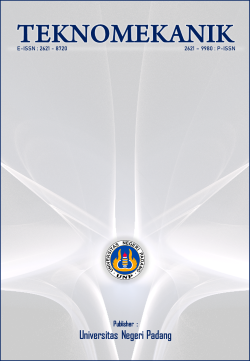The effectiveness of the case method to improve student learning outcomes in the SMAW subject
DOI:
https://doi.org/10.24036/jptk.v6i4.34723Keywords:
Effectiveness, case method, learning outcomes, mechanical engineeringAbstract
This study aims to assess the effectiveness of the case method for improving student learning outcomes in the SMAW (Shielded Metal Arc Welding) subject. This research employs classroom action research. The subjects of this study are 11th-grade students majoring in Mechanical Engineering at State Vocational High School 1 Silaut, West Sumatra, Indonesia. Data collection techniques include observation sheets to assess teacher and student activities, tests to evaluate students’ knowledge, and documentation to support the research. The study results indicate that implementing the case method teaching model effectively improves student learning outcomes because students are engaged and interested in learning. This is evident in the learning outcomes in cycle 1, where 64.29% of students achieved passing grades, with nine passing, while 35.71% did not pass, with five students falling short. In cycle 2, student learning outcomes improved to 78.57%, with 11 students passing, while 21.43% did not pass, with three students not meeting the passing criteria. In conclusion, the case method teaching model effectively enhances student learning outcomes in the SMAW subject.
Downloads
References
Bunyamin, B., Samsudi, S., & Rohman, S. (2022). Journal of Vocational Career Education Soft Skill Improvement Strategy for Vocational High School Students Base on Career and 21st Century Learning Oriented. Journal of Vocational Career Education, 7(1), 65–77. https://doi.org/10.15294/jvce.v7i1.41103
Chan, P., Gerven, T. Van, Dubois, J., & Bernaerts, K. (2021). Virtual chemical laboratories : A systematic literature review of research , technologies and instructional design. Computers and Education Open, 2(2), 100053. https://doi.org/10.1016/j.caeo.2021.100053
Christopher, T. (2022). The Implication of Plato’s Philosophy of Education to the Learner-Centred Teaching in Tanzania Secondary School. East African Journal of Interdisciplinary Studies, 5(1), 207–223. https://doi.org/10.37284/eajis.5.1.726.126
Fernandes, S., Dinis-Carvalho, J., & Ferreira-Oliveira, A. T. (2021). Improving the performance of student teams in project-based learning with scrum. Education Sciences, 11(8), 1–16. https://doi.org/10.3390/educsci11080444
Gerster, J., Boret, S. P., Morimoto, R., Gordon, A., & Shibayama, A. (2022). The potential of disaster digital archives in disaster education: The case of the Japan disasters digital archive (JDA) and its geo-location functions. International Journal of Disaster Risk Reduction, 77(December 2021), 103085. https://doi.org/10.1016/j.ijdrr.2022.103085
Halimah, L., & Sukmayadi, V. (2019). The Role of “Jigsaw” Method in Enhancing Indonesian Prospective Teachers’ Pedagogical Knowledge and Communication Skill. International Journal of Instruction, 12(2), 289–304. https://doi.org/10.29333/iji.2019.12219a
Ishak, D. (2021). Mechanism, Implementation, and Challenges in Independent Campus Education Policy in Indonesia. International Journal of Science and Society, 3(4), 52–63. https://doi.org/10.54783/ijsoc.v3i4.393
Jabarullah, N. H., & Iqbal Hussain, H. (2019). The effectiveness of problem-based learning in technical and vocational education in Malaysia. Education and Training, 61(5), 552–567. https://doi.org/10.1108/ET-06-2018-0129
Jalinus, N., Syahril, & Nabawi, R. A. (2019). A comparison of the problem-solving skills of students in pjBL versus CPjBL model: An experimental study. Journal of Technical Education and Training, 11(1), 36–43. https://doi.org/10.30880/jtet.2019.11.01.005
Jalinus, N., Wulansari, R. E., Heong, Y. M., & Kiong, T. T. (2023). Teaching activities for supporting students ’ 4cs skills development in vocational education. Journal of Engineering Researcher and Lecturer, 2(2), 28–37. https://doi.org/10.58712/jerel.v2i2.95
Lytras, M. D., Serban, A. C., Ruiz, M. J. T., Ntanos, S., & Sarirete, A. (2022). Translating knowledge into innovation capability: An exploratory study investigating the perceptions on distance learning in higher education during the COVID-19 pandemic - the case of Mexico. Journal of Innovation and Knowledge, 7(4), 100258. https://doi.org/10.1016/j.jik.2022.100258
Meltzer, D. E. (2002). The relationship between mathematics preparation and conceptual learning gains in physics: A possible “hidden variable” in diagnostic pretest scores. American Journal of Physics, 70(12), 1259–1268. https://doi.org/10.1119/1.1514215
Meyer, M. W., & Norman, D. (2020). Changing Design Education for the 21st Century. She Ji: The Journal of Design, Economics, and Innovation, 6(1), 13–49. https://doi.org/10.1016/j.sheji.2019.12.002
Miranda, J., Navarrete, C., Noguez, J., Molina-Espinosa, J. M., Ramírez-Montoya, M. S., Navarro-Tuch, S. A., Bustamante-Bello, M. R., Rosas-Fernández, J. B., & Molina, A. (2021). The core components of education 4.0 in higher education: Three case studies in engineering education. Computers and Electrical Engineering, 93(June), 107278. https://doi.org/10.1016/j.compeleceng.2021.107278
Plummer, L., Smith, L., Cornforth, E., & Gore, S. (2021). Teaching psychomotor skills in a virtual environment: An educational case study. Education Sciences, 11(9), 1–12. https://doi.org/10.3390/educsci11090537
Prasetya, F., Fajri, B. R., Wulansari, R. E., Primawati, & Fortuna, A. (2023). Virtual Reality Adventures as an Effort to Improve the Quality of Welding Technology Learning During a Pandemic. International Journal of Online and Biomedical Engineering (IJOE), 19(2), 4–22. https://doi.org/10.3991/ijoe.v19i02.35447
Ramadhan, M. A., Handoyo, S. S., & Cahyati, W. (2021). Trends of Vocational Education and Training Research in Building Construction Engineering. Jurnal Pendidikan Teknologi Kejuruan, 4(2), 47–52. https://doi.org/10.24036/jptk.v4i2.20723
Rashid, Y., Rashid, A., Warraich, M. A., Sabir, S. S., & Waseem, A. (2019). Case Study Method: A Step-by-Step Guide for Business Researchers. International Journal of Qualitative Methods, 18, 1–13. https://doi.org/10.1177/1609406919862424
Szymkowiak, A., Melović, B., Dabić, M., Jeganathan, K., & Kundi, G. S. (2021). Information technology and Gen Z: The role of teachers, the internet, and technology in the education of young people. Technology in Society, 65(1), 101565. https://doi.org/10.1016/j.techsoc.2021.101565
Waskito, Irzal, Wulansari, R. E., & Ya, K. Z. (2022). The Adventure of Formative Assessment with Active Feedback in The Vocational Learning : The Empirical Effect for Increasing Students ’ Achievement. Journal of Technical Education and Training, 14(1), 54–62. https://doi.org/10.30880/jtet.2022.14.01.005
Yada, A., Tolvanen, A., Malinen, O. P., Imai-Matsumura, K., Shimada, H., Koike, R., & Savolainen, H. (2019). Teachers’ self-efficacy and the sources of efficacy: A cross-cultural investigation in Japan and Finland. Teaching and Teacher Education, 81, 13–24. https://doi.org/10.1016/j.tate.2019.01.014
Zhao, W., He, L., Deng, W., Zhu, J., Su, A., & Zhang, Y. (2020). The effectiveness of the combined problem-based learning (PBL) and case-based learning (CBL) teaching method in the clinical practical teaching of thyroid disease. BMC Medical Education, 20(1), 1–10. https://doi.org/10.1186/s12909-020-02306-y
Downloads
Published
Issue
Section
License
Copyright (c) 2023 M Fajrin, Purwantono Purwantono, Irzal Irzal, Bulkia Rahim, Anggi Agni Zaus

This work is licensed under a Creative Commons Attribution 4.0 International License.





